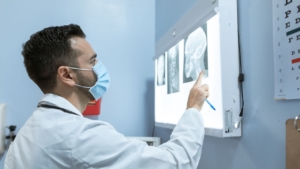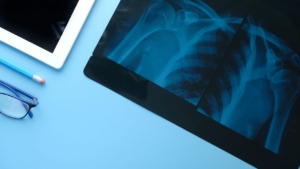Key Takeaways
- Proper shielding minimizes radiation exposure for patients and healthcare professionals.
- Radiation can cause serious health risks without proper shielding.
- Surgical rooms require strategic shielding to ensure minimal exposure during procedures.
- Diagnostic imaging rooms must follow strict safety protocols with effective shielding.
- Lead is a common shielding material, but alternatives like concrete and tungsten exist.
- Routine inspections are necessary to ensure shielding effectiveness over time.
Radiation protection is a critical factor in maintaining a safe environment in surgical and diagnostic rooms. Proper surgical room shielding and diagnostic room safety measures ensure the well-being of both healthcare professionals and patients during imaging procedures.
Radiation shielding services are essential. These ensure that the exposure to radiation in these environments is kept within safe limits. They create a safer work and treatment environment.
Radiation and Its Hazards
Radiation, in the context of medical imaging, is the emission of energy in the form of particles or waves used to create images of the body’s interior. This allows doctors to diagnose and treat various conditions.
While radiation is useful in diagnosing illnesses, overexposure can pose risks to both healthcare professionals and patients. This makes radiation shielding services a critical component of medical imaging centers.
Without proper shielding, radiation exposure can lead to serious health risks. These include radiation burns, tissue damage, and an increased likelihood of long-term effects.
The hazards emphasize the importance of ensuring diagnostic room safety through adequate shielding measures. Protecting those who are exposed to radiation regularly, such as medical staff, is just as important as safeguarding patients.
Importance of Radiation Shielding Services in Healthcare
Surgical Rooms
Surgical rooms often require imaging equipment for procedures. Therefore, the use of radiation during these processes is common.
Surgical room shielding ensures that radiation exposure is minimized for both the patient and the surgical team. Implementing proper shielding solutions creates a safer environment. This reduces the risks while maintaining the efficiency of medical procedures.
Diagnostic Rooms
Diagnostic room safety is crucial in areas where equipment like X-rays, CT scans, and fluoroscopy machines are used. These rooms must adhere to strict safety protocols to protect both staff and patients.
Radiation shielding services play a vital role in ensuring diagnostic room safety by using specific materials that absorb or block radiation, keeping harmful exposure levels within safe limits.
Design Shielded Rooms for Surgical and Diagnostic Imaging
Key Considerations for Surgical Room Shielding
The design of surgical rooms must include careful planning for radiation shielding. The placement of lead-lined walls, ceilings, and floors is crucial in ensuring that radiation does not escape the room.
In addition, the surgical team’s workstations, imaging equipment, and patient positioning must all be factored into the shielding design to optimize protection.
Key Considerations for Diagnostic Rooms Shielding
Diagnostic rooms require even more extensive shielding due to the higher frequency of radiation use.
The layout of these rooms, including control areas where staff operate machines, must consider diagnostic room safety by using materials like lead glass for observation windows and lead doors to separate different areas.
Proper room design, guided by radiation shielding services, is essential to meet safety regulations and maintain a safe environment.
Materials Used in Radiation Shielding
Lead as a Shielding Material
Lead is one of the most common materials used for radiation shielding because of its high density and ability to absorb radiation. Lead-lined walls, doors, and glass are often found in surgical and diagnostic rooms.
This material is effective in creating a barrier that reduces radiation exposure and enhances diagnostic room safety.
Alternatives to Lead
While lead is widely used, other materials like concrete, tungsten, and certain polymers are also effective. These alternatives are often used in specialized settings or when there are environmental concerns regarding the use of lead.
Radiation shielding services can tailor these materials to the specific needs of a facility, depending on the type of imaging equipment and the level of radiation emitted.
Regulatory Standards for Radiation Shielding
Adherence to International and National Guidelines
There are strict regulatory guidelines that govern the use of radiation in healthcare settings. These guidelines, set by national and international organizations, outline the necessary standards for radiation shielding in surgical and diagnostic rooms.
Ensuring compliance with these standards is a key component of radiation shielding services, as non-compliance could lead to fines or operational shutdowns.
Maintain Routine Inspections and Maintenance
Radiation shielding services extend beyond the installation of shielding materials. Routine inspections and maintenance are required to ensure that the shielding remains effective over time.
Facilities must regularly check for any damage or deterioration of materials like lead, ensuring continued protection for both staff and patients.
How Radiation Shielding Services Ensure Safety
Customize Solutions for Healthcare Facilities
Radiation shielding services work by providing customized solutions based on the unique needs of each healthcare facility.
By assessing the equipment used, the size of the rooms, and the frequency of radiation exposure, these services can design a shielding plan. This plan fits the specific requirements of both surgical and diagnostic rooms.
This approach ensures optimal safety and compliance with health regulations.
Training and Education
Aside from installing and maintaining shielding materials, radiation shielding services often include educating staff about radiation safety protocols.
Training ensures that all healthcare professionals are aware of how to minimize their exposure and the importance of adhering to diagnostic room safety guidelines. This further enhances the protective measures implemented by the shielding itself.
Innovations in Radiation Shielding Technology
Advancements in Shielding Materials
New advancements in radiation shielding materials are continuously being made. Innovations such as lightweight composite materials and more environmentally friendly alternatives to lead are emerging.
These innovations improve the practicality and safety of shielding while reducing environmental concerns, providing healthcare facilities with more sustainable options for radiation protection.
Integration with Modern Imaging Equipment
As imaging technology evolves, so too does the need for advanced radiation shielding. Newer imaging systems often require specialized shielding to accommodate their unique emission patterns.
Radiation shielding services keep pace with these technological advancements, ensuring that facilities can safely incorporate the latest equipment into their surgical and diagnostic rooms without compromising safety.
Partner with Spectrum Medical Imaging Co. to Stay Compliant and Safe
At Spectrum Medical Imaging Co., we specialize in providing tailored radiation shielding services that meet the needs of both surgical and diagnostic imaging centers.
With over 40 years of experience, we understand the importance of surgical room shielding and diagnostic room safety. Our expert team will assess your facility, design effective shielding solutions, and provide ongoing support to ensure your healthcare environment remains safe for both staff and patients.
To enhance the protection of your facility, contact Spectrum Medical Imaging Co. today to explore our radiation shielding services.




